Introduction to Poultry Farming in Australia: Poultry farming is the raising of birds (chickens, ducks, and turkeys) domestically or commercially to produce meat or eggs. Chickens that are raised for their meat are called broilers and chickens that are raised for their eggs are called laying hens or layers. Chicken meat remains the most popular protein choice for Australian consumers, comprising 41% of the market share. Therefore, Australia’s demand for chicken meat nearly mirrors this global trend. Generally, poultry includes many species but we are only going to discuss chicken farming in Australia.
A Guide on How To Start Poultry Farming In Australia
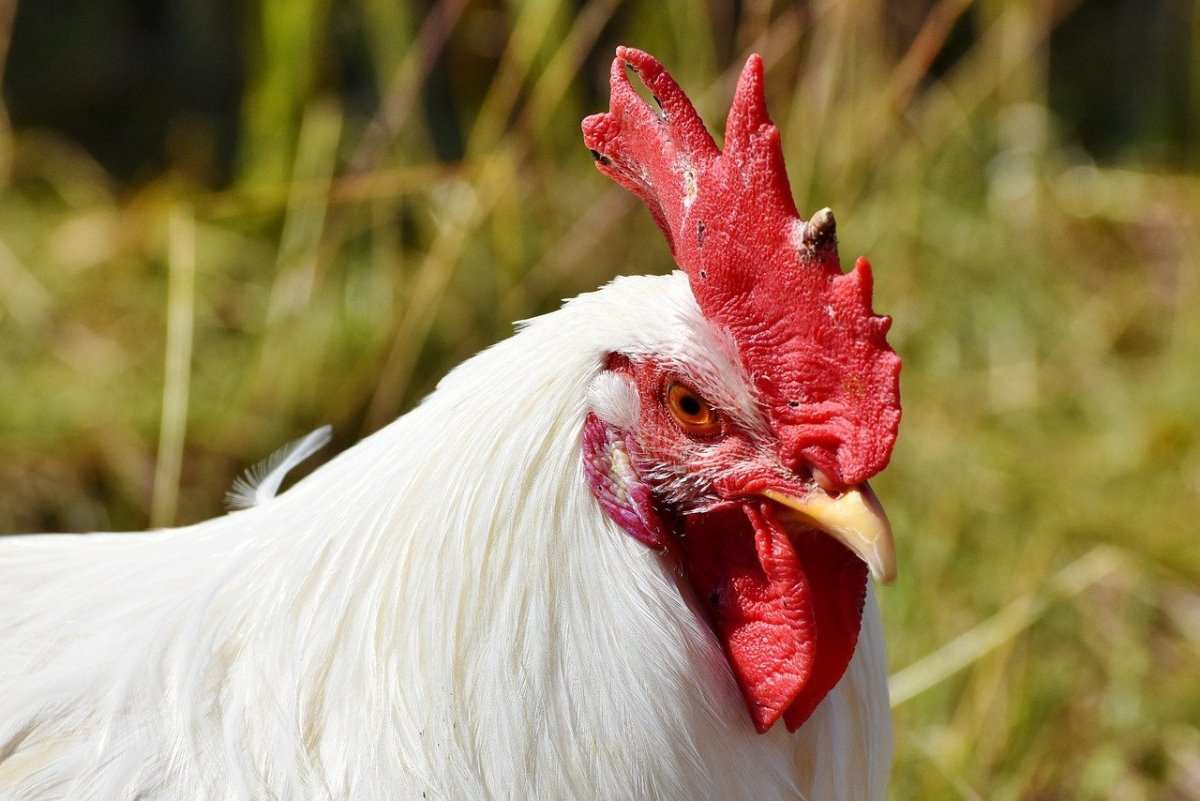
Starting a chicken farm business requires a large capital investment. The upfront investment to establish a farm including sheds, land, water, facilities electricity, and equipment is in an area of several million dollars. Egg farming is the method of raising hens to produce eggs for human consumption.
Chicken Production Systems in Australia
Chicken is the popular poultry species utilized by Australians. The term broiler chicken is a chicken grown for meat, while the term layer is used for egg production. Also, chickens are affectionately referred to as chooks. In Australia, there are many different chicken production systems and markets for both chicken meat and eggs.
For the broiler industry they include;
- Intensive litter furbished sheds
- Free-range
- Certified organic
For the layer industry they include;
- Cage
- Barn
- Free-range
- Certified organic
On top of varied chicken production systems, different diets appeal to different markets including;
- Corn-fed chicken meat
- Vegetarian eggs
- Enriched eggs (e.g. Omega-3)
Organic production systems: To be certified organic, birds must be fed food that is organic, so that it is free of chemical fertilizers, herbicides, or pesticides. There can also be restrictions on the types of vaccinations and medications that certified organic chickens can receive. Poultry birds that are raised as organic must also be free-range. Always check that anything labeled as organic is recognized under a nationally accredited program.
Site Requirement for Poultry Farming in Australia
Land and location must be located near a local sealed road with three-phase power and water access. Farms are generally located within 2 to 3 hours of the processing plant to ensure bird welfare and meat quality. Some other factors that contribute to the location of poultry farms include the distance from the feed mill availability of a reliable water source and access to electricity.
Also, it is best to avoid slopes to minimize earthwork requirements and to be located away from waterways, lakes, and flood-prone areas. Valleys and areas enclosed by thicker vegetation can be suitable, depending on the microclimate conditions and odor dispersal characteristics. Free-range sites need available grazing land to accommodate low bird free-ranging densities probably 1,500 birds per hectare.
Poultry Shed Design Considerations in Australia
Poultry sheds need someone on-site at all times therefore farm housing for the property nearby can be useful and practical, particularly if the poultry is part of a family enterprise. In Australia, meat chickens are farmed in large sheds. Poultry shed sizes change, but a typical new shed is about 150 meters long and 15 meters wide and crams in around 40,000 chickens. Approximately, the largest sheds can hold up to 60,000 broiler or meat chickens. There can be between 3 and 10 sheds on one property. Poultry sheds should always be made based on scientific standards.
If you have made the poultry shed in the wrong direction and wrong, then all the money will be wasted, and poultry birds will not be able to produce based on their ability,
- In the wrongly made shade design, the chicken deaths are also high.
- Also, use the good quality shed to protect poultry birds from wild animals, dogs, cats, etc.
- To keep the poultry shed warm during the winter season and to keep the shed cool during the summer season, arrange coolers, fans, fogs, and so on.
- Carefully make the poultry shed at a little height so that rainwater does not get inside the shed.
Generally, the majority of poultry meat farmers enter into contractual arrangements with poultry processing companies. These contracts include good backup support and also training. Most contract systems usually involve the individual farmer supplying the infrastructure, the water, power, gas, or other energy and labor.
Some processing companies supply chicks including transport of batches to and from the property, feed, veterinary advice, medications, and a management system for the poultry birds. The industry is a full-time commitment and most contracts need that someone is present on-site and contactable by mobile, phone at all times. Significant automation of the operation of broiler sheds has reduced the workload required to manage them. One farm manager can control the normal operations of 1 to 2 broiler sheds.
Benefits of Poultry Farming Business
The poultry farming business has different types of benefits and many farmers prefer to invest in this business. Generally, people establish poultry farms for eggs, meat production, and generating high revenue from these products. Chickens are raised throughout the world as a good food source from their eggs and meat.
Less Capital Required – The poultry farming advantage is that it doesn’t require high capital for starting. You just need basic capital to start raising the poultry business and poultry birds are not expensive to start.
High Returns in Short period – Commercial poultry farming business ensures a high return of investment within a very short period. Broiler chickens take a shorter time duration to mature and also generate profit. Poultry products are not much expensive and they can be afforded by most people.
No Need for a Big Space – The poultry farming business doesn’t need a big space unless you are going to start commercially. Also, you can easily raise birds in your backyard with one or numerous coops or cages. Therefore, if you are interested in poultry farming, then you can simply do it in your backyard with several birds.
High Maintenance not required – High maintenance is not required in poultry farming. Also, you can minimize diseases in poultry by following proper hygiene and care. Diseases are less in some birds like quails and turkeys etc.
License not compulsory – In most cases, you don’t need any license. Also, getting a license from the relevant authority is easy for the poultry business.
Huge Global Demand – Poultry farming has a huge global demand.
Income and Employment Opportunities – Poultry farming mainly creates income and employment opportunities. Unemployed people can make a great income easily by raising the poultry business.
Easy Bank Loans – Almost all banks approve loans for these types of poultry business ventures. Therefore, if you want to start this business commercially, then apply for loans to your local banks.
Starting a Poultry Farm in Australia
Before you start a poultry farm, it is important to have a thorough understanding of all the requirements. These include;
- The market you will target and supply for example under contract with a meat processor
- Site selection
- Registrations
- The development application process
- Environmental laws and requirements
- Environmental management of the farm
- The production system you will use (e.g. caged, barn, free-range)
- The health and welfare requirements of the poultry birds.
Caring for Poultry Birds
Poultry housing systems can provide controlled conditions such as;
- Temperature
- Lighting
- Humidity
- Ventilation
Feed formulas, water quality, hygiene, stocking density, and management skills, including observation and attention, are also very important. Consultant poultry nutritionists can advise on feed requirements for independent growers.
Light Management – The lights for the chicken are the most important thing and the eggs give the commercial chicken a required 16 hours of light. Though, the chick necessary provides 12 hours of night light (Natural Light) to 24 hours. Light depends on the weather conditions and the breed etc., and this basis only light. Generally, for the Broiler breed, 24 hours light is given. Yellow, red, and orange color light offer good results in poultry birds.
Classification of Poultry Breeding
In case if you miss this: Dairy Farming In Canada.
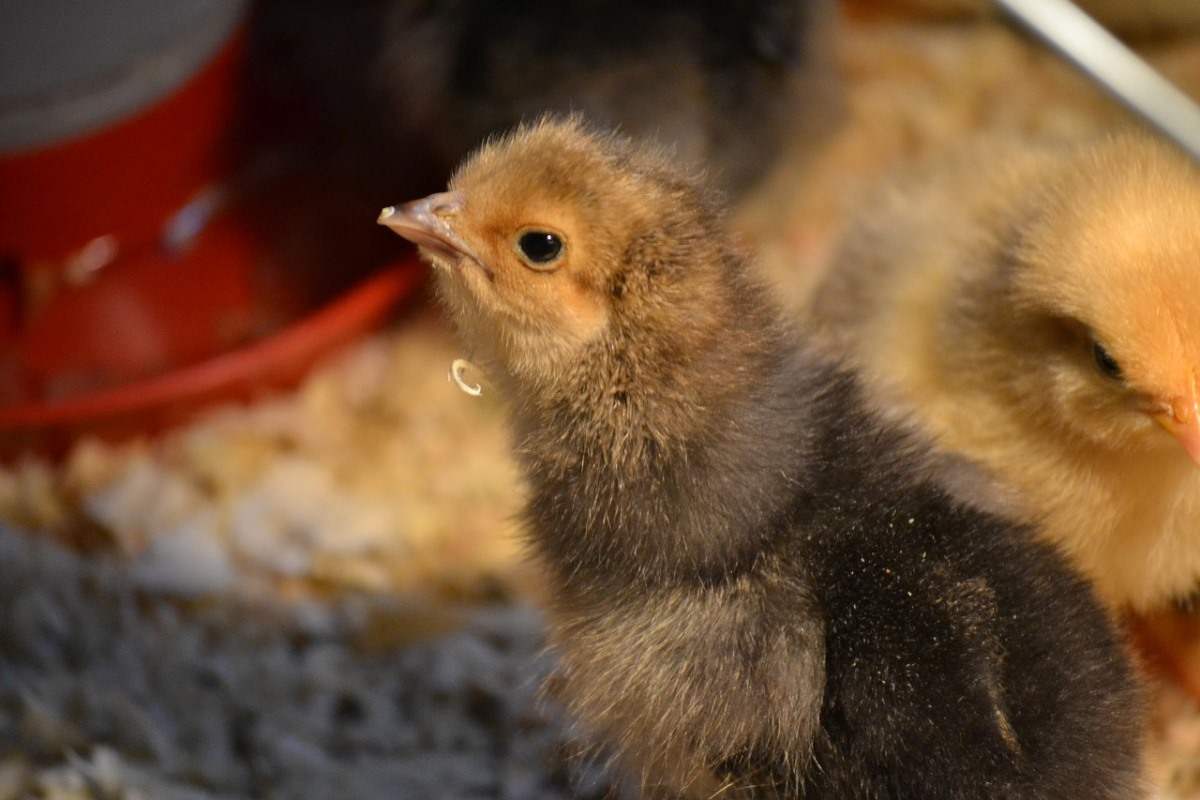
Poultry breeding can be divided into 3 main areas which include;
Commercial Breeding
Chicken is the most popular poultry species utilized by Australians. Then, breeding for the commercial poultry sector is on a large industrial scale and hatcheries supply the broiler and layer industries. The broiler is used by the poultry industry to describe a chicken grown for meat production. The layer is used for chickens grown for egg production. Also, chickens are affectionately referred to as “chooks”.
Village/Backyard Breeding
Some farmers and suburban householders keep poultry birds for egg and meat production. Some growers use small colony cages or use a few layer cages in a protected spot. Other people buy day-old chicks and rear their birds.
Fancy/Exhibition Breeding
Many poultry breeds play little part in the commercial poultry industry. These are called fancy poultry and are kept by small producers who enjoy breeding, showing, and exchanging birds with other fanciers.
Popular Chicken Breeds in Australia
There are many chicken breeds to choose from in Australia;
Different chicken breeds will have varying characteristics so make sure you do your research before purchasing. Additionally, take into consideration whether the chickens you buy will be happy in the local climate. Chickens are slaughtered between 6 to 8 weeks of age at around 3 kgs. Normally it can take a chicken 96 days to reach 2 kgs. The same feeding species are common and completely unregulated in Australia.
Breed Characteristics
Consistent Egg Layers – Leghorn, Australian Langshan, Rhode Island Red, Australorp, Wyandotte, Orpington
Great Pets – Ameraucana, Silkie, Pekin, Australorp, Brahma, and Booted Bantam
Show Chicken breeds – Ameraucana, Booted bantam, Houdan, and Buff laced Polish
Tasty Meat – Australian Langshan, Dorking, Plymouth Rock, Delaware, and Brahma
Many chicken breed varieties have extraordinary plumage and color and even lay unusually colored eggs.
Some of the most popular chicken breeds in Australia are given below;
Australorps – Australorps are an Australian native breed. Australorps are of decent size, and weigh 3 to 4 kg (hens ~ 3.1 kg; roosters ~ 3.9 kg). Bantam varieties, weighing about 0.7-1.2 kg (hens ~ 0.85 kg; roosters ~ 1.1 kg), are also available. While it cannot be realistic to expect 364 eggs a year from Australorps, they can be expected to produce 250 to 300 medium-large light brown eggs per year. In terms of appearance, there are black, white, and blue colors Australorps, with the back being the most common and blue being relatively rare. Due to their large size, the birds aren’t great fliers. So, their wings need not be clipped, and fencing can be relatively low.
Barnevelder – Barnevelders are great dual-purpose poultry birds. While originally Barnevelder eggs were noted to be a chocolate brown color, the color of their eggs has softened to be brown to light brown color likely as a result of selective breeding for show. This could make their eggs may seem less impressive and this isn’t necessarily the case. It is typical for Barnevelders to lay about 200 eggs and year and continue laying throughout the winter season at a slightly slower rate. While they reside more on the egg production end of the dual-purpose spectrum, they are decent table birds.
Easter Eggers – Easter Eggers is an extremely popular and fantastic addition to backyard flocks. As their name suggests, one of the main features that make Easter Eggers popular is that they lay a variety of different colored eggs, typically including greed, blue, and even slightly pink eggs. It is important to note that the color of eggs that an individual Easter Egger lays is determined by its parentage and will remain consistent throughout its life.
Australian Langshan – This breed has strong genetics, several color variations, and favorable dispositions, making it frequently appearing bread on show circuits around the country. Australian Langshan bantams are well regarded as exceptional family-friendly backyard birds due to their smaller size.
Australian Pit Game – It is one of the most loosely standardized breeds in Australia. It can be large or small, any color and cock feathered, hen feathered or muffled. Due to their ancestry as fighting birds the standard does not regard color as important but instead focuses on health and vigor.
Australian Game – Australian Game’s breed is hard and brittle. Australian Game birds are large, solid, and muscular and are considered good meat birds. They were originally known as Colonials and were highly prized for their stamina and great courage.
Leghorn – Leghorns are a great egg-producing breed that is highly economical and provides you with lots of eggs for a relatively small cost. These birds are active and independent creatures that aren’t fond of handling. Leghorns are broadly considered dual-purpose birds, and they are small (hens ~ 2.5kg; roosters ~ 3.4kg) and muscular birds that are predominantly utilized as egg layers rather than as table birds. Though, their small size plays to the Leghorn’s favor as an egg layer. Also, Leghorns are highly active birds that are keen foragers able to sustain themselves and obtain most of their nutrition from foraging. This makes Leghorns a highly economical bird for egg production purposes. You can expect between 250 to 320 medium to large white eggs.
You may also check this: Sheep Farming In Australia.
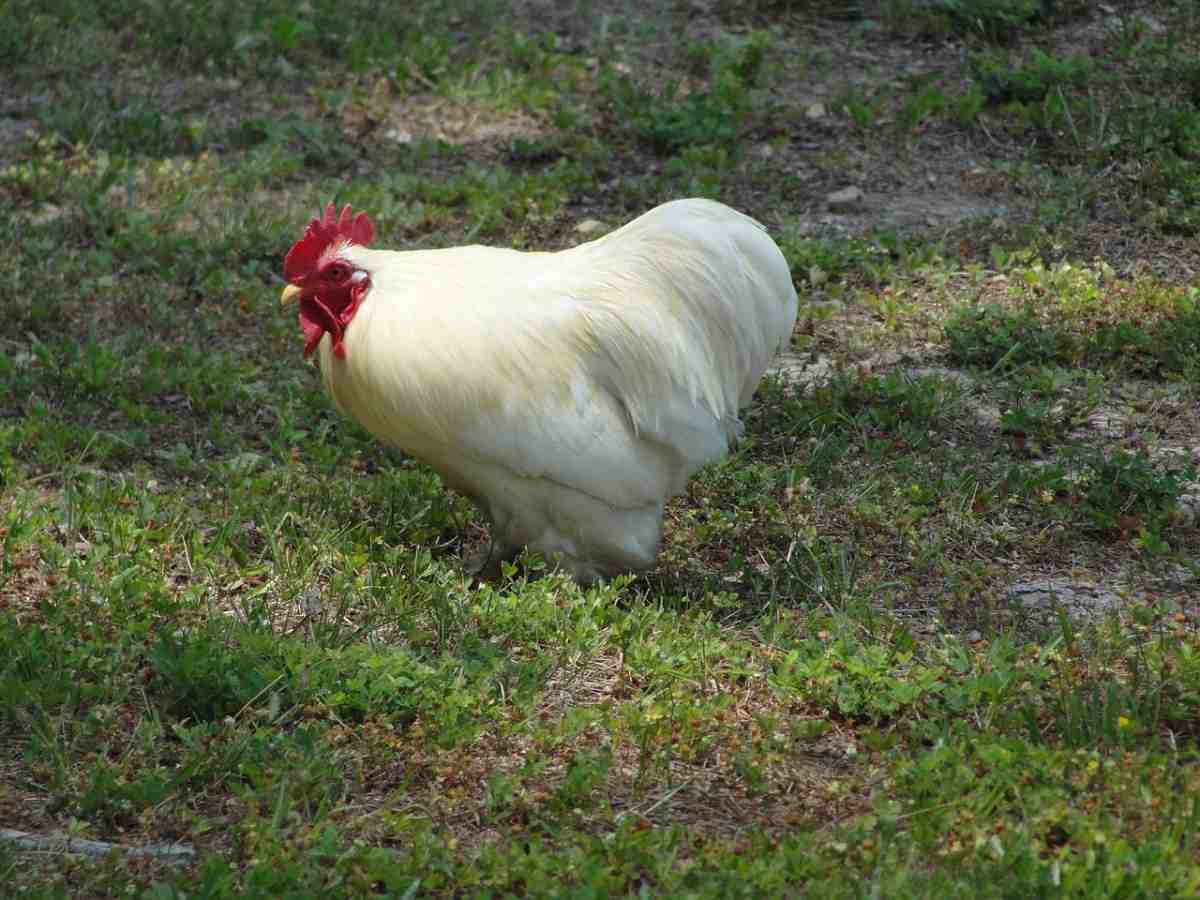
Rhode Island Red – If you are looking for a great all-purpose breed that is suitable for all Australian climate conditions, the Rhode Island Red could be for you. They are amazing layers of extra-large eggs and are good birds to raise for meat.
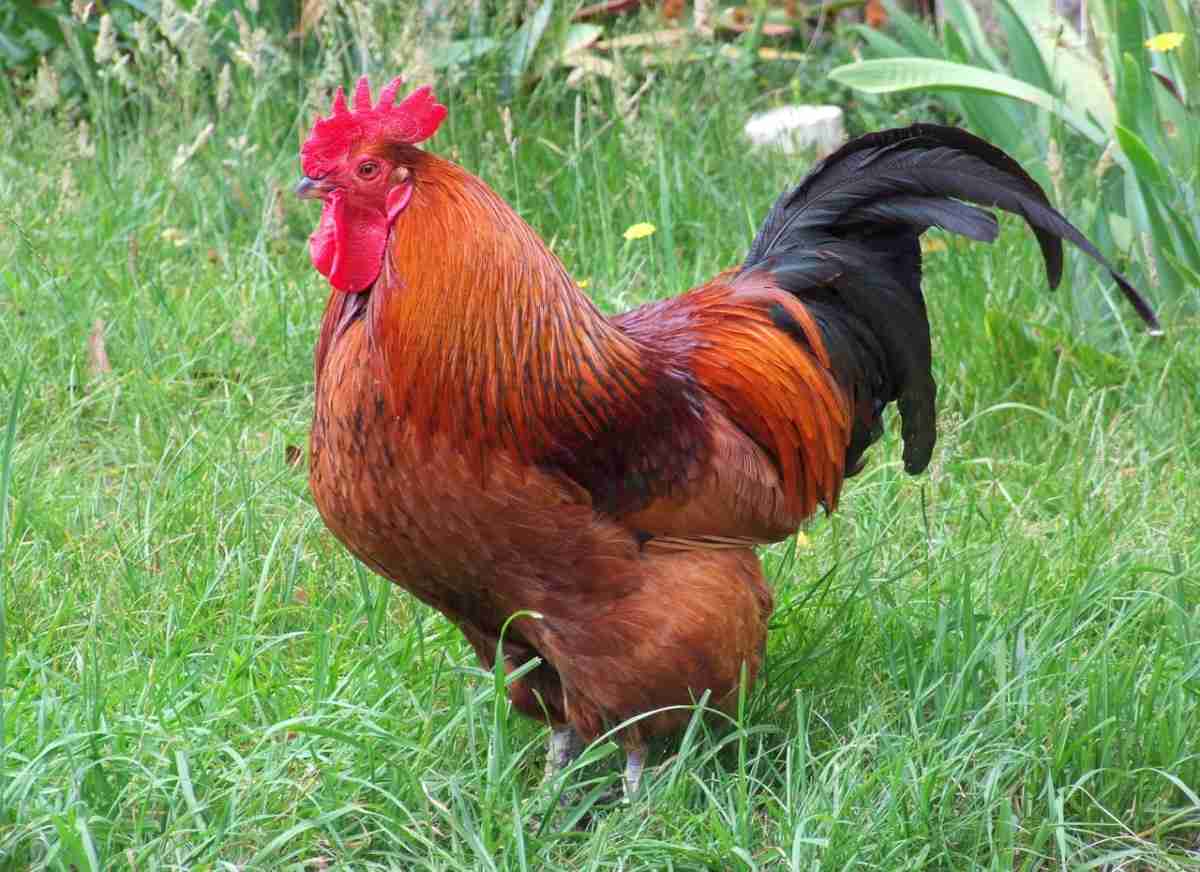
Egg-Laying Breeds in Australia
Some breeders will conveniently offer a point of Layer chickens, and these chickens are about to start laying. These chickens are around 4 to 6 months old.
The most consistent egg-laying breeds are ISA Brown, Leghorn, Australian Langshan, Rhode Island Red, Australorp, Wyandotte, and Orpington breeds.
Meat Chicken (Broiler) Industry in Australia
commercial meat chicken farms are intensive, highly mechanized operations that occupy a small area compared with other forms of farming. Australian broiler breeds are not kept in cages, regardless of the production system used. The main production systems are referred to as conventional, free-range, and organic.
Generally, processing companies contract out the growing of their broiler chickens to contract chicken growers. These poultry growers on the farm provide the management, shedding, equipment, labor, bedding, and other inputs for the rearing of the chickens. The processing company provides, and at all times owns, the chickens and then provides the feed, medication, and technical advice. The terms and conditions of the grower contracts, as well as the growing fees, are recognized by state government constituted committees in some states, or by negotiation between growers or groups of growers and companies in other states.
The payment includes a performance-based component. About 800 growers produce about 80% of Australia’s meat chickens under contract to processing companies. The majority of meat chickens are produced on large company farms, or on farms owned and also managed by ‘intermediary’ companies that own some farms.
The three main poultry producing companies own their breeding farms, supplemented by some contract operators, and supply eggs to their company’s hatchery. Several companies have their research farms. Also, each of the larger companies operating in the industry has a product research and development facility.
Chicken is marketed throughout Australia by large and medium-sized integrated companies under many brand names through numerous outlets. Brands range from nationally recognized names to state-recognized names and house brands. Also, numerous smaller processors market chicken either under their particular brand or in some cases without any brand identification, other than their name and address on the original packaging.
Major meat chicken growing areas in Australia are;
- Outskirts of the Sydney metropolitan area, Newcastle, Tamworth, and Griffith areas;
- Redland Bay south of Brisbane, and other regions to the south, south-west, and north of Brisbane in Queensland;
- Mornington Peninsula, east of Melbourne, and Bendigo areas in Victoria;
- Outskirts of Adelaide and also the Two Wells area in South Australia;
- Outer metropolitan areas of Perth.
Chicken Farm Sequence Process
Hatchery to Farm
In this process, newly hatched chicks are transported to broiler farms in ventilated chick boxes. Ventilated chick boxes are carefully designed to carry chicks.
Brooding or Starting Phase
In starting phase, day-old chicks are placed onto the poultry shed floor, where they are initially confined to an area. The air temperature under the brooder should initially be 35 to 34°C and reduced by 1 to 2°C per day until it reaches 23°C when the chickens are 3 weeks of age and kept constant. Australian meat chickens are raised on litter floors, but some overseas companies use wire-floored cage systems for raising meat chickens.
Growing or Finishing Phase
At this finishing phase, growth is still very important, but since feed is expensive careful costing is carried out to keep expenses to a minimum. Therefore, a low amino acid density diet is fed to the chickens for the remainder of their life usually until 42 days of age. Then, heavyweight birds that are required for chicken fillets are slaughtered at up to 56 days of age. A coccidiostat, sometimes a different one from that used in the starter feed, is added to the finisher feed.
Harvesting Phase
In the harvesting stage, getting finished meat chickens from the farm to the factory is a delicate poultry business. Most catching is done at night when the birds are quieter, and this gets them to the processor early in the morning. Though, delays can result in stress and weight loss. Mechanical devices for harvesting meat chickens have been invented, but results are variable and most Australian meat chickens are still caught by hand. Poultry birds are placed into plastic crates designed for good ventilation from bruising during transport. After that, these modules are handled by specialist forklift equipment and loaded onto trucks for transport to the processing plant. In Australia, a percentage of chickens are harvested up to 4 different times depending on the need for light or heavy birds. Also, harvesting is called ‘partial depopulation’, ‘thinning out, or ‘multiple pick-ups’. In these, thinning out sheds allows more space for the remaining birds and reduces the natural temperature in the shed. The first harvest can occur as early as 30 to 35 days of age and the last harvest at 55 to 60 days of age.
Poultry Nutrient Requirements in Australia
Poultry nutrient diets must be formulated to meet the bird’s nutrient requirements. There are mainly 6 classes of essential nutrients;
- Carbohydrates – It is the major source of energy for poultry.
- Fats – They provide energy and essential fatty acids required for some bodily processes.
- Proteins – It is required for synthesizing body tissue (mainly muscle), physiological molecules like enzymes and hormones, and feathers and egg production. Also, proteins provide a small amount of energy.
- Vitamins – It is organic chemicals (chemicals containing carbon) that help control body processes and are required in small amounts for normal health and growth.
- Minerals – It is inorganic chemicals (chemicals not containing carbon) required for normal health and growth.
- Water
Several factors can affect the voluntary feed intake of poultry; these include:
- Breed or strain
- Age
- Nutrient balance of the diet
- Ambient temperature
- Health and welfare status of the poultry birds
- Accessibility of the feed
- Flock density
Poultry Feeding Options
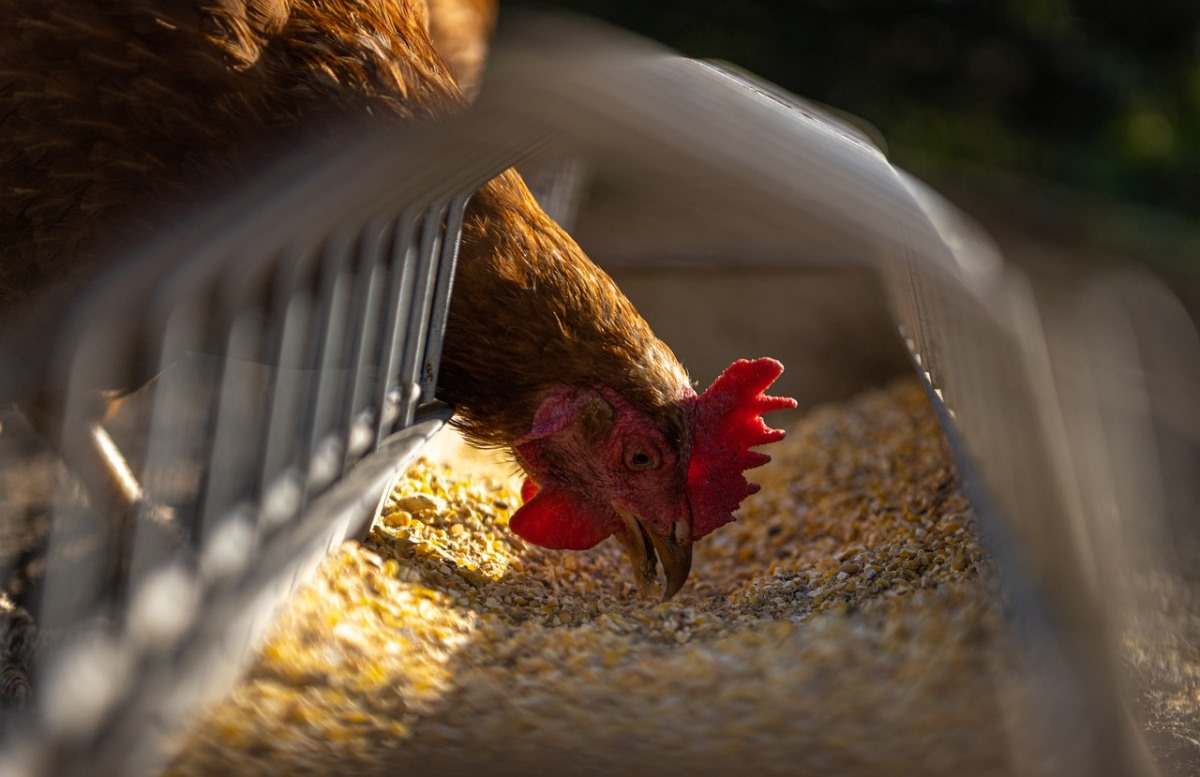
Generally, commercially raised chickens are fed what is known as a complete feed that includes all the protein, energy, vitamins, minerals, and other nutrients essential for proper growth, egg production, and bird health. Raw and unprocessed beans have enzyme inhibitors that interfere with digestion and nutrient absorption. Soybeans are a readily obtainable and popular feedstuff and are always processed before being sold as a feed ingredient.
Why Do Chickens Grow To Market Weight So Quickly?
Around 50 to 60% of the improvement in bird growth rates since the start of intensive poultry farming is due to improved breeds of chickens. Then, this genetic gain, which has been achieved through conventional selective breeding, is due to;
A further 20 to 25% of the improvement in growth is due to improved nutrition. For current meat chicken breeds, the nutrient requirements such as energy, protein, essential amino acids, vitamins, and minerals at each stage of its growth have been studied precisely. For each feed ingredient, the levels of these nutrients digestible by the chicken have been established. The feed can be formulated to match the chicken’s precise nutritional requirements throughout its life cycle, thereby optimizing growth and feed efficiency. Other gains in meat chicken growth and performance are due to better husbandry methods and health management.
Water Consumption Rates for Chickens
Water is an essential nutrient for poultry bird’s life, and water consumption can be limited if the water is too hot or is contaminated with excess minerals. There are other types of factors that affect water intake, with temperature being the most obvious one. For example, chickens drink between 30 to 50% more water when the environmental temperature level is above 32°C compared with when it is 21°C. Also, water intake is affected by the type of drinkers used. Usually, the rule of thumb for water intake is 1.5 to 2 times feed intake.
Poultry Bird Vaccination
Vaccination plays an important role in the health management of the poultry flock. A vaccine helps to boost the immune system of birds and prevent disease. Give the vaccine on your poultry farm occasionally and then follow the company’s schedule selling chicks.
Health Management for Poultry Farming in Australia
Diseases in Poultry Birds: Diseases of poultry have several causes and include;
- Deficiencies of essential nutrients like vitamins, minerals, or other nutrients.
- The consumption of toxic substances.
- Physical damage, e.g., environmental extremes and injury.
- Internal and external parasite infestations.
- Microorganisms like bacteria and viruses cause an infectious disease.
Diseases that result from nutrient deficiencies and consumption of toxic substances are referred to as non-infectious diseases. In the widest sense, infectious diseases are mainly caused by microorganisms that include parasites, fungi, protozoa, bacteria, mycoplasmas, chlamydia, and viruses. These diseases are also called contagious diseases, meaning that they can be passed from one bird to another either directly or indirectly.
For poultry health management to be effective, a primary aim should be to prevent the onset of disease and to recognize at an early stage the presence of disease. To know how to identify that the birds are diseased, the action required for preventing or minimizing disease, and how to monitor for signs that the disease prevention program is working.
Conclusion
If you live in Australia and plan to start Poultry Farming, this article may help you to understand the process of starting a Poultry Farming business from scratch.
- Economical Aquaculture: A Guide to Low-Budget Fish Farming
- 15 Common Planting Errors That Can Doom Your Fruit Trees
- How to Make Houseplants Bushy: Effective Tips and Ideas
- Innovative Strategies for Boosting Coconut Pollination and Yield
- Pollination Strategies for Maximum Pumpkin Yield
- The Complete Guide to Chicken Fattening: Strategies for Maximum Growth
- Natural Solutions for Tulip Problems: 100% Effective Remedies for Leaf and Bulb-Related Issues
- Revolutionizing Citrus Preservation: Towards a Healthier, Greener Future
- Natural Solutions for Peony Leaf and Flower Problems: 100% Effective Remedies
- Maximizing Profits with Avocado Contract Farming in India: A Comprehensive Guide
- Natural Solutions for Hydrangea Problems: 100% Effective Remedies for Leaf and Flowers
- The Ultimate Guide to Choosing the Perfect Foliage Friend: Bringing Life Indoors
- From Sunlight to Sustainability: 15 Ways to Use Solar Technology in Agriculture
- The Ultimate Guide to Dong Tao Chicken: Exploring from History to Raising
- The Eco-Friendly Makeover: How to Convert Your Unused Swimming Pool into a Fish Pond
- Mastering the Art of Delaware Chicken Farming: Essentials for Healthy Backyard Flocks
- 20 Best Homemade Fertilizers for Money Plant: DIY Recipes and Application Methods
- How to Craft a Comprehensive Free-Range Chicken Farming Business Plan
- Brighten Your Flock: Raising Easter Egger Chickens for Beauty and Bounty
- How to Optimize Your Poultry Egg Farm Business Plan with These Strategies
- Subsidy for Spirulina Cultivation: How Indian Government Schemes Encouraging Spirulina Farmers
- Ultimate Guide to Raising Dominique Chickens: Breeding, Feeding, Egg-Production, and Care
- Mastering the Art of Raising Jersey Giant Chickens: Care, Feeding, and More
- Ultimate Guide to Raising Legbar Chickens: Breeding, Farming Practices, Diet, Egg-Production
- How to Raise Welsummer Chickens: A Comprehensive Guide for Beginners
- How to Protect Indoor Plants in Winter: A Comprehensive Guide
- Ultimate Guide to Grow Bag Gardening: Tips, Tricks, and Planting Ideas for Urban Gardeners
- Guide to Lotus Cultivation: How to Propagate, Plant, Grow, Care, Cost, and Profit
- Agriculture Drone Subsidy Scheme: Government Kisan Subsidy, License, and How to Apply Online
- Ultimate Guide to Raising Araucana Chickens: Breed Profile, Farming Economics, Diet, and Care
I start new layer poultry business in sheeperton east Victoria from where I get permission to start poultry business.